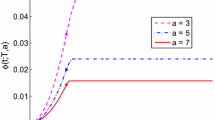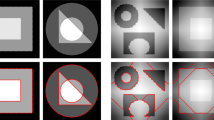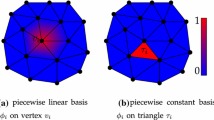Abstract
The Mumford–Shah model has been one of the most influential models in image segmentation and denoising. The optimization of the multiphase Mumford–Shah energy functional has been performed using level sets methods that optimize the Mumford–Shah energy by evolving the level sets via the gradient descent. These methods are very slow and prone to getting stuck in local optima due to the use of gradient descent. After the reformulation of the 2-phase Mumford–Shah functional on a graph, several groups investigated the hierarchical extension of the graph representation to multi class. The discrete hierarchical approaches are more effective than hierarchical (or direct) multiphase formulation using level sets. However, they provide approximate solutions and can diverge away from the optimal solution. In this paper, we present a discrete alternating optimization for the discretized Vese–Chan approximation of the piecewise constant multiphase Mumford–Shah functional that directly minimizes the multiphase functional without recursive bisection on the labels. Our approach handles the nonsubmodularity of the multiphase energy function and provides a global optimum if the image estimation data term is known apriori.








Similar content being viewed by others
Explore related subjects
Discover the latest articles, news and stories from top researchers in related subjects.References
Badshah, N., & Chen, K. (2009). On two multigrid algorithms for modeling variational multiphase image segmentation. IEEE Transaction on Image Processing, 18(5), 1097–1106.
Bae, E., & Tai, X. C. (2009). Efficient global minimization for the multiphase Chan–Vese model of image segmentation. In International Conference on Energy Minimization Methods in Computer Vision and Pattern Recognition, EMMCVPR ’09 (pp. 28–41).
Bae, E., & Tai, X. C. (2009). Graph cut optimization for the piecewise constant level set method applied to multiphase image segmentation. In International Conference of Scale Space and Variational Methods in Computer Vision (pp. 1–13).
Bae, E., Yuan, J., & Tai, X. C. (2011). Global minimization for continuous multiphase partitioning problems using a dual approach. International Journal of Computer Vision, 92(1), 112–129.
Boros, E., Hammer, P. L., & Tavares, G. (2006). Preprocessing of unconstrained quadratic binary optimization. Tech. Rep. RRR 10–2006, RUTCOR.
Boykov, Y., Veksler, O., & Zabih, R . (1999). Fast approximate energy minimization via graph cuts. In International Conference for Computer Vision, ICCV99 (Vol. 1, pp. 377–384).
Bresson, X., Esedognlu, S., Vandergheynst, P., Thiran, J. P., & Osher, S. (2007). Fast global minimization of the active contour/snake model. Journal of Mathematical Imaging and Vision, 2, 151–167.
Brown, E., Chan, T., & Bresson, X. (2010). A convex approach for multiphase piecewise constant Mumford–Shah image segmentation. Tech. Rep. CAM 09–66, UCLA.
Bruckstein, A., Netravali, A., & Richardson, T. (1997). Epi-convergence of discrete elastica. Applicable Analysis, 79(1–2), 137–171.
Chan, T. F., & Vese, L. A. (2001). Active contours without edges. IEEE Transation on Image Processing, 10(2), 266–277.
Chung, G., & Vese, L. A. (2005). Energy minimization based segmentation and denoising using a multilayer level set approach. In International Conference on Energy Minimization Methods in Computer Vision and Pattern Recognition (pp. 439–455).
Collins, D. L., Zijdenbos, A. P., Kollokian, V., Sled, J. G., Kabani, N. J., Holmes, C. J., et al. (1998). Design and construction of a realistic digital brain phantom. IEEE Transactions on Medical Imaging, 17(3), 463–468.
Darbon, J., & Sigelle, M. (2005). A fast and exact algorithm for total variation minimization. IbPRIA, 3522(1), 351–359.
Delong, A., & Boykov, Y. (2009). Global optimal segmentation of multi-region objects. In International Conference on Computer Vision (Vol. 1, pp. 26–33).
El-Zehiry, N., & Elmaghraby, A. (2008). A graph cut based active contour without edges with relaxed homogeneity constraint. In International Conference on Pattern Recognition (pp. 1–4).
El-Zehiry, N., Xu, S., Sahoo, P., & Elmaghraby, A. (2007). Graph cut optimization for the mumford-shah model. In International Conference on Visualization, Imaging and Image Processing (pp. 182–187).
El-Zehiry, N., Sahoo, P., & Elmaghraby, A. (2011). Combinatorial optimization of the piecewise constant Mumford–Shah functional with application to scalar/vector valued and volumetric image segmentation. Image and Vision Computing, 29, 365–381.
El-Zehiry, N. Y. (2009). A graph cut framework for two dimensional/three dimensional implicit front propagation with application to the image segmentation problem. PhD thesis, Louisville, KY.
El-Zehiry, N. Y., & Elmaghraby, A. (2007). Brain MRI tissue classification using graph cut optimization of the Mumford–Shah functional. In Inernational Vision Conference of New Zealand, New Zealnd (pp. 321–326).
Grady, L., & Alvino, C. (2009). The piecewise smooth Mumford–Shah functional on an arbitrary graph. IEEE Transaction on Image Processing, 18(11), 2547–2561.
Grady, L., & Polimeni, J. R. (2010). Discrete calculus: Applied analysis on graphs for computational science. New York: Springer.
Hammer, P. L., Hansen, P., & Simeone, B. (1984). Roof duality, complementation and persistency in quadratic 01 optimization. Mathematical Programming, 28(2), 121–155.
Ishikawa, H. (2003). Exact optimization for Markov random fields with convex priors. IEEE Transaction on Pattern Analysis and Machine Intelligence, 25, 1333–1336.
Jeon, M., Alexander, M., Pedrycz, W., & Pizzi, N. (2005). Unsupervised hierarchical image segmentation with level set and additive operator splitting. Pattern Recognition Letters, 26, 1461–1469.
Kahl, F., & Strandmark, P. (2011). Generalized roof duality for pseudo-boolean optimization. In International Conference on Computer Vision (pp. 255–262).
Kohli, P., Kumar, M. P., & Torr, P. H. S. (2009). P & beyond: Move making algorithms for solving higher order functions. IEEE Transaction on Pattern Analysis and Machine Intelligence, 31(9), 1645–1656.
Kolmogorov, V. (2003). Graph based algorithms for scene reconstruction from two or more views. PhD thesis, Cornell University.
Kolmogorov, V., & Boykov, Y. (2005). What metrics can be approximated by geo-cuts, or global optimization of length/area and flux. In International Conference on Computer Vision, ICCV05 (Vol. 1, pp. 564–571).
Kolmogorov, V., & Rother, C. (2007). Minimizing nonsubmodular functions with graph cuts-a review. IEEE Transaction on Pattern Analysis and Machine Intelligence, 29(7), 1274–1279.
Kolmogorov, V., & Zabih, R. (2004). What energy functions can be minimized via graph cuts? IEEE Transaction on Pattern Analysis and Machine Intelligence, 26(2), 147–159.
Komodakis, N., & Tziritas, G. (2007). Approximate labeling via graph cuts based on linear programming. IEEE Transaction on Pattern Analysis and Machine Intelligence, 29(8), 1436–1453.
Kwan, R. S., Evans, A., & Pike, G. (1999). MRI simulation-based evaluation of image-processing and classification methods. IEEE Transactions on Medical Imaging, 18(11), 1085–1097.
Lellmann, J., Becker, F., & Schnörr, C. (2009). Convex optimization for multi-class image labeling with a novel family of total variation based regularizers. In International Conference on Computer Vision (pp. 646–653).
Martin, D., Fowlkes, C., Tal, D., & Malik, J. (2001). A database of human segmented natural images and its application to evaluating segmentation algorithms and measuring ecological statistics. In International Conference on Computer Vision (Vol. 2, pp. 416–423).
Mumford, D., & Shah, J. (1988). Optimal approximations by piecewise smooth functions and variational problems. Communications of, Pure and Applied Mathematics, XLII(5), 577–685.
Ni, K., Hong, B. W., Soatto, S., & Chan, T. (2009). Unsupervised multiphase segmentation: A recursive approach. Computer Vision and Image Understanding, 113(4), 502–510.
Osher, S., & Sethian, J. A. (1988). Fronts propagating with curvature-dependent speed: Algorithms based on Hamilton–Jacobi formulations. Journal of Computational Physics, 79(1), 12–49.
Pock, T., Schoenemann, T., Graber, G., Bischof, H., & Cremers, D. (2008). A convex formulation of continuous multi-label problems. In European Conference on Computer Vision (pp. 792–805).
Pock, T., Cremers, D., Bischof, H., & Chambolle, A. (2009). An algorithm for minimizing the Mumford-Shah functional. In International Conference on Computer Vision (pp. 1133–1140).
Ramalingam, S., Kohli, P., Alahari, K., & Torr, P. H. S. (2008). Exact inference in multi-label CRFs with higher order cliques. In IEEE Conference on Computer Vision and Pattern Recognition (pp. 1–8).
Rother, C., Kolmogorov, V., Lempitsky, V., & Szummer, M. (2007). Optimizing binary MRFs via extended roof duality. IEEE Conference on Computer Vision and Pattern Recognition, 5302, 248–261.
Simon, H., & Teng, S. H. (2001). How good is recursive bisection? SIAM Journal on Scientific Computing, 18(5), 1436–1445.
Vazquez-Reina, A., Miller, E., & Pfister, H. (2009). Multiphase geometric couplings for the segmentation of neural processes. IEEE Conference Computer Vision and, Pattern Recognition (pp. 2020–2027).
Vese, L. A., & Chan, T. F. (2002). A multiphase level set framework for image segmentation using the Mumford and Shah model. International Journal of Computer Vision, 50(3), 271–293.
Wainwright, M., Jaakkola, T., & Willsky, A. (2002). MAP estimation via agreement on (hyper)trees: Message-passing and linear programming approaches. IEEE Transactions on Information Theory, 51, 3697–3717.
Yuan, J., Bae, E., Boykov, Y., & Tai, X. C. (2011). A continuous max-flow approach to minimal partitions with label cost prior. In Scale Space and Variational Methods in Computer Vision (pp. 279–290).
Author information
Authors and Affiliations
Corresponding author
Rights and permissions
About this article
Cite this article
El-Zehiry, N.Y., Grady, L. Combinatorial Optimization of the Discretized Multiphase Mumford–Shah Functional. Int J Comput Vis 104, 270–285 (2013). https://doi.org/10.1007/s11263-013-0617-0
Received:
Accepted:
Published:
Issue Date:
DOI: https://doi.org/10.1007/s11263-013-0617-0




